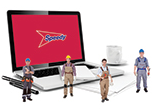
How to Rotavate Your Garden
Rotavating your garden is a great way to prepare your outdoor space before laying turf or planting seeds, bulbs, and plants in flower beds.
Rotavating churns and aerates the soil, improving drainage and making the ground easier to work with.
It can also uncover buried debris, reduce soil compaction, and allow water and nutrients to better reach the roots of plants and grass. This gives your greenery a more suitable home to prosper in.
Using a petrol rotavator for large garden areas can save you lots of valuable DIY time reducing the risk of back injuries, compared to manually digging with a shovel. The blades of the rotavator break up the soil for you, and they are powerful pieces of equipment which don’t require back-breaking amounts of work.
Keep your garden in tip-top condition by investing time and effort into your garden maintenance. Read our blog to find out what tools and steps are required to prepare and rotavate your garden.
What tools do I need to rotavate my garden?
- Rotavator
- Rake
What Safety and PPE equipment do I need?
Before you use a rotavator it is really important that you wear the correct PPE. Eye protection, safety boots and gloves are essential, and we would also recommend using ear defenders.
Keep materials and sharp tools out of children’s and pets' reach and remember to always check the operators and safety guidance before using any hire equipment.
How to use a rotavator
Before you begin, it is vital to check the moisture levels of your soil and get an idea of the type of soil you will be working with. Soil which is really compacted, such as if it has been under a patio or outbuilding, will be harder to work with and you could just find the rotavator only scrapes away at the top few inches.
Likewise, clay soil can be harder to dig into. Ground which is too wet can just clump once rotavated when it dries, and it will stick to the blades of the machine. Sandy soil will be the easiest to work with and is unaffected by moisture levels, so you should be good to go once you’ve prepared your surface.
If you think your soil will be difficult to work with, water it three or four days before you hire your rotavator. Spring and autumn are the best times to rotavate, which avoids extreme weather conditions and allows for softer ground.
Preparing your garden
Before rotavating, you need to get rid of as much debris as possible. Any stones, twigs or rubble should be removed by hand and disposed of correctly. Rotavating may bring up further debris, so remove this as and when it is uncovered to avoid injury or kickbacks from your rotavator.
You should also remove all weeds. This will prevent them from spreading, rooting, and growing again once your soil is prepared, which would just create more work in the future.
Be careful around any large trees as the machine could kick if it hits a root.
Steps to rotavate your garden
For large garden areas, we recommend using a powered rotavator. This makes light work of breaking up compacted soil and turning it over, bringing all the nutrients to the surface and improving drainage.
Step 1: Start up the machine
Read the instruction booklet which comes with your hire to prepare you for the use of your rotavator. Once you have set everything up, start the machine and begin to slowly move forward over the area.
Step 2: Work lengthways
You should ideally work lengthways across your soil when rotavating. This will allow you to keep track of where has already been covered and will also create natural channels if you are planting flowerbeds, vegetables, or shrubs. But if your ground is particularly hard to work with, going in different directions will be beneficial to begin with.
- Speedy Top Tip! Planning on using manure or fertilised compost because you’re planting flowers or vegetables? Add it after the first pass and rotavate again, to help mix it with existing soil.
Step 3: Repeat until you have the desired effect
The desired end result will depend on what you’re planning to do with the area and the condition of your soil. If you are sowing seeds, you will need finer soil than if you’re laying turf.
You can repeat the process as much as necessary until you are comfortable with the finish. This may require one pass, or up to four or five.
Step 4: Prepare your surface for planting
If you are adding a layer of new turf or planting grass seed, add a fine layer of topsoil over the rotavated garden area. Use a rake until the topsoil is even.
Step 5: Let the ground settle
Let the ground settle before you lay your new turf, sprinkle grass seed or plant anything. Holes may appear after rotavating which you will need to fill with additional topsoil and rake again. Waiting for a few days should be plenty of time.
You especially don’t want a bumpy lawn that you have to dig up again!
What is the difference between a cultivator, rotavator and tiller?
Wondering whether you need to hire a cultivator or a rotavator? What even is a tiller? The terms can often be interchanged and confused, and while they all do a similar job, they are separate products.
A rotavator, as above, is perfect for larger outdoor areas. You may have got rid of an old lawn, patio or outbuilding and realised the ground underneath needs serious attention. If you’ve just moved home, you may also want to completely redo the garden and redesign in your own style. Rotavators have wheels that drive it along with the blades behind, and they go deep into the soil properly turning everything over.
A tiller is better for more compact areas, as they are smaller to manoeuvre. They are still powerful appliances, however, but are lighter and don’t go as deep as rotavators.
A cultivator has no wheels and is just driven by the blades. These are best used to mix any soil which is already loose, as opposed to breaking up the ground.
Is there rotavator hire near me?
Yes. Speedy, the UK's leading tool hire company, have a range of rotavators for hire nationwide. Speedy has more than 200 service centres across the nation, hire counters in selected B&Qs and nationwide 4-hour delivery, rotavator hire has never been easier.
You’ll find all the tools you need right here. Why not start planning your next DIY project and open a Speedy account today online and in store.
Ready for more Gardening DIY tips and ideas?
Thank you for reading the Speedy Services blog, we hope you found this how to rotavate your garden guide useful, please check out our Gardening Projects page for further inspiration.
- 2024
- 2023
- December 2023 (13)
- November 2023 (10)
- October 2023 (6)
- September 2023 (10)
- August 2023 (20)
- July 2023 (21)
- June 2023 (17)
- May 2023 (17)
- April 2023 (17)
- March 2023 (14)
- February 2023 (15)
- January 2023 (7)
- 2022
- December 2022 (6)
- November 2022 (12)
- October 2022 (24)
- September 2022 (14)
- August 2022 (12)
- July 2022 (15)
- June 2022 (18)
- May 2022 (14)
- April 2022 (9)
- March 2022 (5)
- February 2022 (5)
- January 2022 (2)
- 2021
- December 2021 (7)
- November 2021 (10)
- October 2021 (1)
- September 2021 (1)
- August 2021 (3)
- July 2021 (3)
- June 2021 (4)
- May 2021 (1)
- April 2021 (1)
- March 2021 (2)
- February 2021 (1)
- January 2021 (1)
- 2020
- 2019
- 2017
- 2016
- 2014
- 2013
- 2012
- 2011


